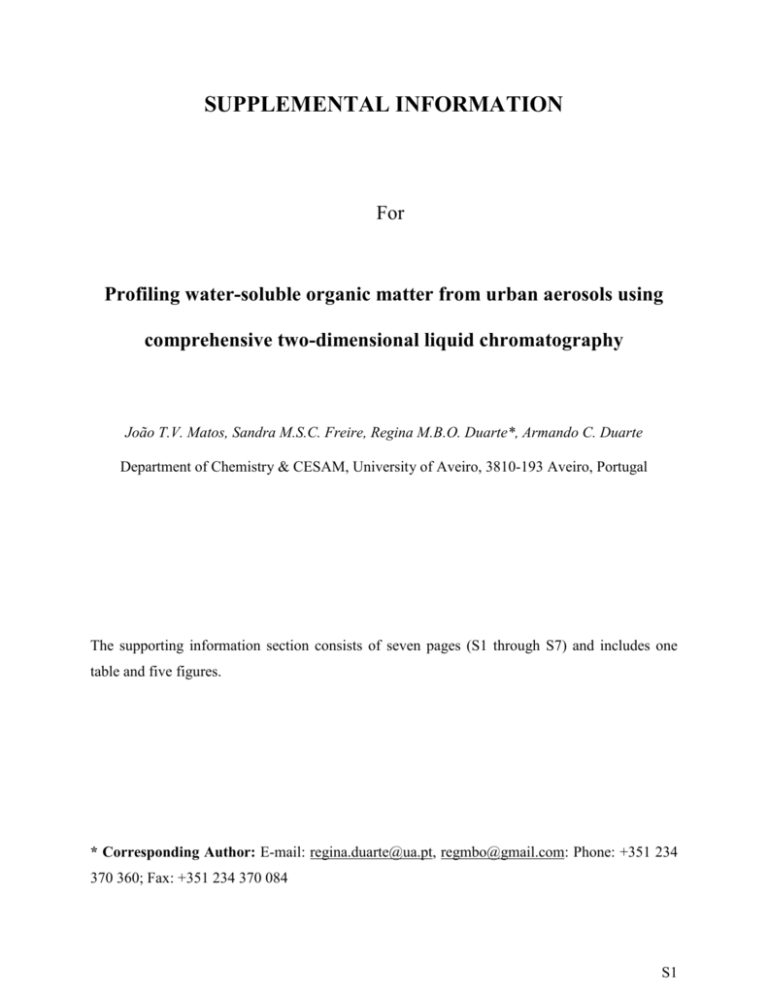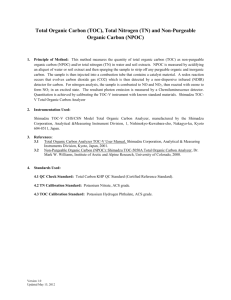Template for Electronic Submission to ACS Journals
advertisement

SUPPLEMENTAL INFORMATION For Profiling water-soluble organic matter from urban aerosols using comprehensive two-dimensional liquid chromatography João T.V. Matos, Sandra M.S.C. Freire, Regina M.B.O. Duarte*, Armando C. Duarte Department of Chemistry & CESAM, University of Aveiro, 3810-193 Aveiro, Portugal The supporting information section consists of seven pages (S1 through S7) and includes one table and five figures. * Corresponding Author: E-mail: regina.duarte@ua.pt, regmbo@gmail.com: Phone: +351 234 370 360; Fax: +351 234 370 084 S1 S1. Detailed information on the sampling site Atmospheric aerosol samples were collected in the campus of University of Aveiro (40°38'N, 8°39'W), which is located at about 7 km from the coast on the outskirts of the small town of Aveiro with approximately 78.400 inhabitants and an urban area of 13.5 km². The sampling site is located 1 km away from the A25 motorway, and adjacent to a residential area and a salt pans area of the Lagoon of Ria de Aveiro. An industrial complex, which includes the production of nitric acid, aniline and nitrobenzene, is about 10 km north of Aveiro. The sampling site is impacted by both marine air masses travelling from the Atlantic Ocean and anthropogenic emissions from vehicular transport, residential, and industrial sources. S2. Meteorological data acquired during sampling campaigns Figure S1. Variability of the relative humidity recorded on an hourly basis for each season. S2 Figure S2. Variability of the air temperature recorded on an hourly basis for each season. Figure S3. Wind rose with the wind speed and direction for each season. S3 S2. Determination of organic and elemental carbon content in PM2.5 samples The determination of organic carbon (OC) and elemental carbon (EC) content in the aerosol samples was performed at the Portuguese Agency of Environment, using a Lab OC-EC Aerosol Analyzer (Sunset Laboratory Inc.) and following a thermo-optical method (Birch, M.E. and Cary, R.A., 1996. Elemental carbon-based method for occupational monitoring of particulate diesel exhaust: methodology and exposure issues. The Analyst, 121 (9), 1183–90). As with other (thermal and thermo-optical) procedures applied to the analysis of OC and EC in aerosol samples, the contents of OC and EC are operationally defined and should follow a strict standard operating procedure (SOP). Briefly, in a completely oxygen (O2)-free helium (He) atmosphere, a small portion (1.5 cm2) of the quartz fibre filter is heated in four increasing temperature steps (60 sec at 315 ºC, 60 sec at 475 ºC, 60 sec at 615 ºC, and 90 sec at 870ºC) to remove all OC from the filter. The transition from the third to the fourth temperature (i.e., from 615 ºC to 870 ºC) quickly decomposes inorganic carbonates, producing a sharp, characteristic peak. During this first stage of analysis, a fraction of OC is usually pyrolitically converted to EC, named pyrolytic carbon (PC). This pyrolitic conversion is continuously monitored by measuring the transmission of a laser through the filter. As the organic compounds are vaporized, they are immediately oxidized to carbon dioxide (CO2) in an oxidizer oven which follows the sample oven. The flow of He, containing the CO2, then goes to a methanator oven where the CO2 is reduced to methane (CH4), which is then detected by a flame ionization detector (FID). At the end of the fourth step of the temperature program, the sample oven is cooled to 550 ºC (50 sec). After this step, the pure He flow composition is switched to a 2% O2/He mixture in the sample oven and the temperature is stepped up to 940 °C. During this second stage of analysis, both the original EC and the PC are oxidized to CO2 due to the presence of O2 in the carrier gas. As previously, the CO2 is then S4 reduced to CH4 and detected by the FID. The darkness of the filter is continuously monitored throughout all stages of the analysis. Finally, after all carbon has been oxidized from the sample, a known volume and concentration of CH4 is injected into the sample oven in order to calibrate each measurement to a known quantity of carbon. This also provides the basis of checking the operation of the instrument: with the FID response and laser transmission data, the quantities of OC and EC are calculated for each sample. S3. Determination of dissolved organic carbon content in aqueous extracts of the aerosol samples The dissolved organic carbon (DOC) content of each aqueous extract of the aerosol samples was measured in a Shimadzu TOC-5000A analyser, using the non-purgeable organic carbon (NPOC) mode. Briefly, the procedure started by acidifying 10 mL of each standard/sample with 6 µL of 6M HCl (pH 3) immediately before sparging with ultra-high purity air for 2 minutes. Then, each standard/sample was injected (25 µL) into the total carbon (TC) furnace of the analyzer, where it was catalytically oxidized to CO2 according to the principle of the NPOC method. For NPOC quantification, standards were prepared from reagent grade potassium hydrogen phthalate in ultrapure water in the range of 0 to 1 mg C L-1. For each sample, five determinations of NPOC were considered and only the mean values of areas with standard deviation less than 200 (peak area count) and/or a variation coefficient less than 2% were considered as acceptable. S5 Figure S4. (a) Two-dimensional and (b) three-dimensional representation of the peak regional maxima location in the PALC×SEC–DAD chromatogram of the WSOM hydrophobic acids from the AU2009 urban aerosol samples. S4. Calibration of separation mechanisms in both dimensions Table S1. Molecular formula, molecular weight, and the location of the PALC×SEC–ELSD peak maximum for the eight atmospherically relevant organic compounds. Name 1. Citric Acid 2. Adipic Acid 3. D(+)-Glucose 4. D(+)-Trehalose Dihydrate 5. Glycine 6. Levoglucosan 7. L-Isoleucine 8. Catechol Molecular formula Molecular weight (Da) C6H8O7 C6H10O4 C6H12O6 C12H22O11.2H2O C2H5NO2 C6H10O5 C6H13NO2 C6H6O2 192 146 180 378 75.1 162 131 110 PALC×SEC–ELSD First Dimension (min) 85.0 95.8 109 109 111 115 125 193 Second Dimension (Da) 176 169 70.4 80.5 76.2 50.7 57.3 144 S6 Figure S5. Two-dimensional representation of the peak regional maxima location in the PALC×SEC–ELSD chromatogram of (1) Citric Acid, (2) Adipic Acid, (3) D(+)-Glucose, (4) D(+)-Trehalose Dihydrate, (5) Glycine, (6) Levoglucosan, (7) L-Isoleucine, and (8) Catechol. S7







